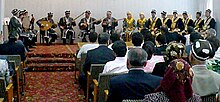| Shashmaqam | |
|---|---|
 Shashmaqam in Tajikistan | |
| Native name | Шашмақом / Shashmaqom |
| Cultural origins | Tajik and Uzbek music |
| Typical instruments | Long-necked lutes, dayra, and sato |
| Shashmaqom music | |
|---|---|
| Country | Tajikistan and Uzbekistan |
| Reference | 00089 |
| Region | Asia and the Pacific |
| Inscription history | |
| Inscription | 2008 (3rd session) |
| List | Representative |
Shashmaqom (/ˌʃæʃməˈkɒm/ SHASH-mə-KOM; Uzbek: [ˌʃæʃmaˈqɒm]; Tajik: [ʃɐʃmɐˈqɔm]) is a Central Asian musical genre (typical of Tajikistan and Uzbekistan) which may have developed in the city of Bukhara. Shashmaqam means the six Maqams (modes) in the Persian language, dastgah being the name for Persian modes, and maqams being the name for modes more generally.
It is a refined sort of music, with lyrics derived from Sufi poems about divine love. The instruments of shashmaqоm provide an austere accompaniment to the voices. They consist, at most concerts, of a pair of long-necked lutes (rawap, tar, tanbur or dutar), the dayra, or frame drum, which, with its jingles, is very much like a tambourine, and the sato, or bowed tanbur.